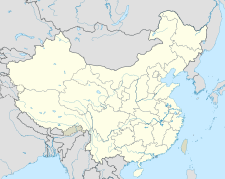Imparavis
This article relies largely or entirely on a single source. (March 2024) |
| Imparavis Temporal range: Lower Cretaceous (Aptian),
| |
|---|---|
| Scientific classification | |
| Domain: | Eukaryota |
| Kingdom: | Animalia |
| Phylum: | Chordata |
| Clade: | Dinosauria |
| Clade: | Saurischia |
| Clade: | Theropoda |
| Clade: | Avialae |
| Clade: | †Enantiornithes |
| Genus: | †Imparavis |
| Species: | †I. attenboroughi
|
| Binomial name | |
| †Imparavis attenboroughi Wang et al., 2024
| |
Imparavis (meaning "odd bird") is an extinct genus of enantiornithine birds from the Early Cretaceous (Aptian-aged) Jiufotang Formation of Liaoning Province, China. The genus contains a single species, I. attenboroughi, known from a well-preserved skeleton.[1]
Discovery and naming
The Imparavis holotype specimen, STM11-176, was discovered in sediments of the Jiufotang Formation near Toudaoyingzi village in Jianchang County, Liaoning Province, China. The holotype is preserved on a single slab, consisting of an articulated, nearly complete specimen, preserved in ventral view. It is missing part of the vertebral column and most of the gastralia. Faint feather traces are visible around parts of the skeleton.[1]
In 2024, Wang et al. described Imparavis attenboroughi as a new genus and species of enantiornithine bird based on these fossil remains. The generic name, "Imparavis", combines the Latin words "impar", meaning "odd", and "avis", meaning "bird". The specific name, "attenboroughi", honors David Attenborough and his work with natural history presentation and wildlife preservation.[1]
Classification
In their phylogenetic analyses, Wang et al. recovered Imparavis as a member of the Enantiornithes, as the sister taxon to Yuornis in a clade also containing Gobipteryx. The results of their analyses are shown in the cladogram below, with toothless taxa highlighted.[1]
References
- ^ a b c d Wang, Xiaoli; Clark, Alexander D.; O'Connor, Jingmai K.; Zhang, Xiangyu; Wang, Xing; Zheng, Xiaoting; Zhou, Zhonghe (2024-02-27). "First Edentulous Enantiornithine (Aves: Ornithothoraces) from the Lower Cretaceous Jehol Avifauna". Cretaceous Research. 159 (in press): 105867. Bibcode:2024CrRes.15905867W. doi:10.1016/j.cretres.2024.105867. ISSN 0195-6671.
- Articles with short description
- Short description is different from Wikidata
- Articles needing additional references from March 2024
- All articles needing additional references
- Articles with 'species' microformats
- Taxonbars with multiple manual Wikidata items
- Taxonbars without primary Wikidata taxon IDs
- Taxonbars without secondary Wikidata taxon IDs
- Enantiornitheans
- Early Cretaceous birds of Asia
- Prehistoric bird genera
- Aptian genera
- Jiufotang fauna
- Fossil taxa described in 2024
- Birds described in 2024
- All stub articles
- Prehistoric bird stubs


